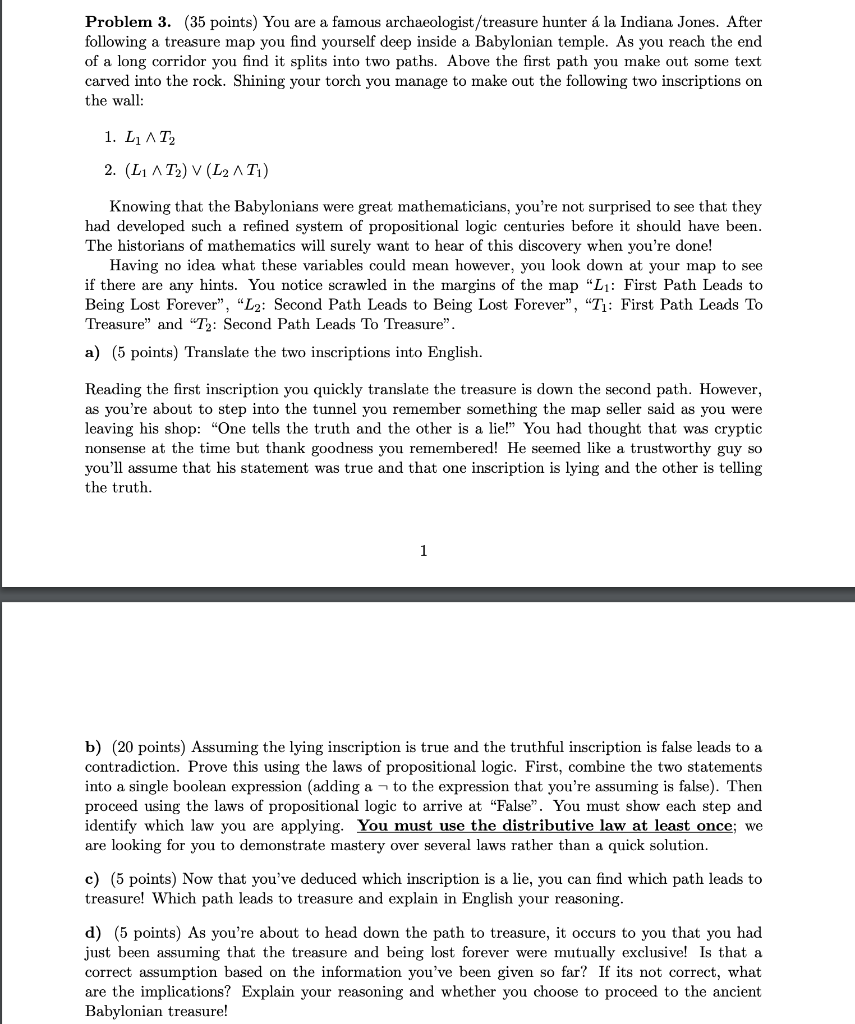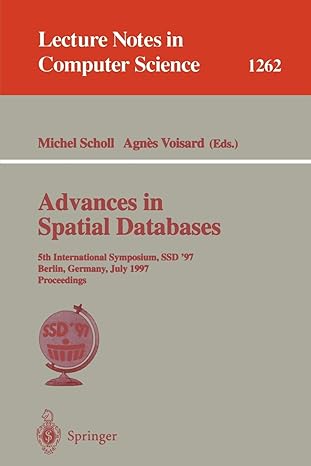
Problem 3. (35 points) You are a famous archaeologist/treasure hunter la Indiana Jones. After following a treasure map you find yourself deep inside a Babylonian temple. As you reach the end of a long corridor you find it splits into two paths. Above the first path you make out some text carved into the rock. Shining your torch you manage to make out the following two inscriptions on the wall: 1. LAT, 2. (L1 AT2) V (L2 AT1) Knowing that the Babylonians were great mathematicians, you're not surprised to see that they had developed such a refined system of propositional logic centuries before it should have been. The historians of mathematics will surely want to hear of this discovery when you're done! Having no idea what these variables could mean however, you look down at your map to see if there are any hints. You notice scrawled in the margins of the map "L1: First Path Leads to Being Lost Forever", "L2: Second Path Leads to Being Lost Forever", "Ti: First Path Leads To Treasure" and "T2: Second Path Leads To Treasure". a) (5 points) Translate the two inscriptions into English. Reading the first inscription you quickly translate the treasure is down the second path. However, as you're about to step into the tunnel you remember something the map seller said as you were leaving his shop: "One tells the truth and the other is a lie!" You had thought that was cryptic nonsense at the time but thank goodness you remembered! He seemed like a trustworthy guy so you'll assume that his statement was true and that one inscription is lying and the other is telling the truth. b) (20 points) Assuming the lying inscription is true and the truthful inscription is false leads to a contradiction. Prove this using the laws of propositional logic. First, combine the two statements into a single boolean expression adding a to the expression that you're assuming is false). Then proceed using the laws of propositional logic to arrive at "False. You must show each step and identify which law you are applying. You must use the distributive law at least once; we are looking for you to demonstrate mastery over several laws rather than a quick solution. c) (5 points) Now that you've deduced which inscription is a lie, you can find which path leads to treasure! Which path leads to treasure and explain in English your reasoning. d) (5 points) As you're about to head down the path to treasure, it occurs to you that you had just been assuming that the treasure and being lost forever were mutually exclusive! Is that a correct assumption based on the information you've been given so far? If its not correct, what are the implications? Explain your reasoning and whether you choose to proceed to the ancient Babylonian treasure! Problem 3. (35 points) You are a famous archaeologist/treasure hunter la Indiana Jones. After following a treasure map you find yourself deep inside a Babylonian temple. As you reach the end of a long corridor you find it splits into two paths. Above the first path you make out some text carved into the rock. Shining your torch you manage to make out the following two inscriptions on the wall: 1. LAT, 2. (L1 AT2) V (L2 AT1) Knowing that the Babylonians were great mathematicians, you're not surprised to see that they had developed such a refined system of propositional logic centuries before it should have been. The historians of mathematics will surely want to hear of this discovery when you're done! Having no idea what these variables could mean however, you look down at your map to see if there are any hints. You notice scrawled in the margins of the map "L1: First Path Leads to Being Lost Forever", "L2: Second Path Leads to Being Lost Forever", "Ti: First Path Leads To Treasure" and "T2: Second Path Leads To Treasure". a) (5 points) Translate the two inscriptions into English. Reading the first inscription you quickly translate the treasure is down the second path. However, as you're about to step into the tunnel you remember something the map seller said as you were leaving his shop: "One tells the truth and the other is a lie!" You had thought that was cryptic nonsense at the time but thank goodness you remembered! He seemed like a trustworthy guy so you'll assume that his statement was true and that one inscription is lying and the other is telling the truth. b) (20 points) Assuming the lying inscription is true and the truthful inscription is false leads to a contradiction. Prove this using the laws of propositional logic. First, combine the two statements into a single boolean expression adding a to the expression that you're assuming is false). Then proceed using the laws of propositional logic to arrive at "False. You must show each step and identify which law you are applying. You must use the distributive law at least once; we are looking for you to demonstrate mastery over several laws rather than a quick solution. c) (5 points) Now that you've deduced which inscription is a lie, you can find which path leads to treasure! Which path leads to treasure and explain in English your reasoning. d) (5 points) As you're about to head down the path to treasure, it occurs to you that you had just been assuming that the treasure and being lost forever were mutually exclusive! Is that a correct assumption based on the information you've been given so far? If its not correct, what are the implications? Explain your reasoning and whether you choose to proceed to the ancient Babylonian treasure







